
views
Finding a Dog

Research breeds. Different dog breeds have different personalities and different needs. Research different breed types and find the breeds that you will best be able to care for. There are a number of online resources as well as books and magazines dedicated to different dog breeds to help you in your search. Match the breed to your activity level. Some dog breeds are more energetic than others. If you are a sedentary person who enjoys quiet activities, it would be ill-advised to adopt breed of dog known for its high energy, such as Boxer or a Jack Russell Terrier. Instead, look at quiet breeds like Pekingese or Shih Tzus. Take your living area into account. Think about adopting a dog on the smaller side if you live in an apartment. Larger dogs can live in smaller areas, but special care should be taken to ensure they receive the proper amount of exercise. On the other hand, some small dogs may feel overwhelmed or in a dangerous environment at a home with acres of land. Determine your time constraints. If you adopt a puppy, you may have to do all the training. Older dogs may already be housebroken and have some training. Additionally, some dogs simply need more stimulation throughout the day. Consider how much time you have to give to your new dog.

Look at special needs dogs. Consider whether you would like to adopt a special needs dog. Special needs dogs come in many forms, from those needing extra vet care and those who have physical disabilities to those who may have been abused and have behavioral or emotional issues. Ensure you understand the needs of the dog before you commit to adopting it. A dog that has a chronic condition may require frequent trips to the vet. Make sure you can handle that expense if that is the kind of care your special needs dog requires. Set aside some extra time for the dog. Many dogs are nervous when they are first brought to a new home, and that can be compounded for special needs dogs. Make sure you have extra time set aside when you first adopt the dog to familiarize it with you, anyone else in your home, and the new space. Ask the shelter or rescue, “What specifically will I need to do and to supply in order to properly care for this dog?”
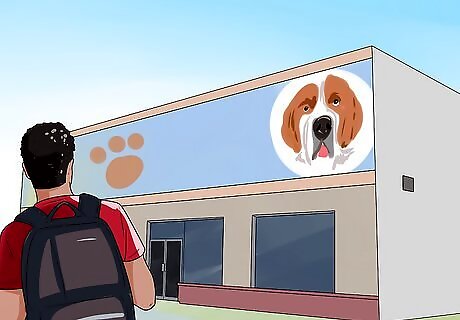
Visit your shelter. Dog breeds of all ages and training levels may be found at a shelter. Call and ask to set up a visit so that you can come by and meet the adoptable dog. Also ask them how you might be able to meet dogs in their foster program, if they have one. Consider looking at the shelter’s website before you visit. Many shelters have information regarding adoptable pets both in their shelter and in their foster home program. Read over pet profiles to get to know the dogs’ personalities as well as their individual needs. Put your name on the shelter's call list if you are looking for a very specific type of dog, such as a rare breed. Most shelters will give you a call if a certain type of dog is brought to them. Contact your local breed rescue. If you want to adopt a certain breed of dog or desire a purebred, look online or in the phone book for numbers to a breed rescue.
Preparing for a New Dog
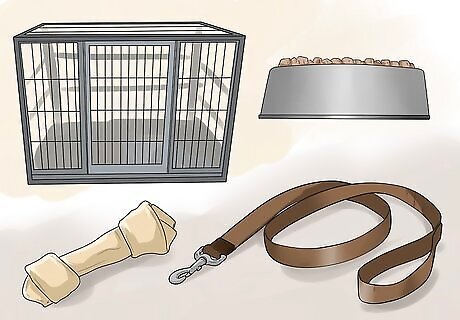
Buy items you will need to care for a dog. This may include a collar and leash, food and water bowls, and appropriate food. You may also want to buy a crate or a carrier, toys, dog bed, and training treats. Here is a list of useful supplies: Food dish Dog food Water dish Harness or collar Leash Tag Dog bed A crate A travel carrier A dog bed and/or a blanket New toys
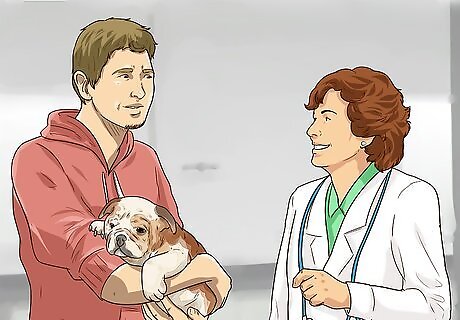
Find a vet. You likely don’t need to set up a patient profile with a vet before you adopt your dog, but shelters often ask you to find a veterinary practice you want to use before you bring your dog home. This ensures that you are prepared from the moment you bring your dog home. Contact local vets and ask about their experience with your kind of dog. If you are adopting a certain breed, ask the vet if they are comfortable working with that breed. If you are getting a special needs pet, ask the vet if they have experience caring for your dog’s particular needs. Ask about a wellness plan. Many vets do puppy and dog wellness plans that include a certain number of visits and services, such as vaccines and heartworm tests, a year. Ask your vet if they offer packages at a discounted rate to help keep your new dog covered.

Dog-proof your house. If your house is not already set up for your new dog, go through and make sure you remove or relocate potential hazards for your new pet. The extent of dog-proofing will depend largely on the size of your dog and its personality, but steps to take often include: Blocking access to stairs that may lead to areas you do not want your dog, or that may be harmful to small puppies Covering trash cans without lids Securing low-set cabinets that the dog may be able to access, especially if you keep food or cleaning products in them Moving or blocking anything with sharp corners or edges that could cut Covering toilets, especially those with sanitizing flush products Ensuring you have a fenced-in yard or area for your dog to spend time outside Removing or barricading any potentially harmful plants, such as fruits, vegetables, and palm trees, in your yard or home Assessing other areas as needed
Adopting Your New Dog
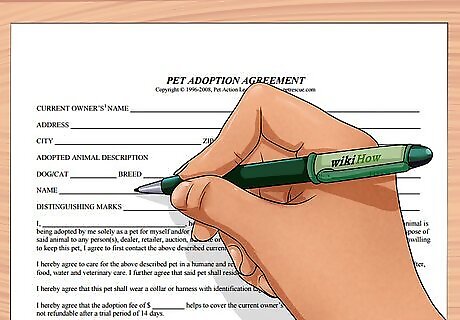
Fill out the paperwork. Once you have found a dog you like and you have prepared yourself and your home for their arrival, start the adoption process by filling out the necessary paperwork with the shelter or rescue. Let the shelter know that you are ready to adopt, confirm the dog you want is still available, and ask them to send you a copy of the adoption paperwork. Adoption paperwork can be a lengthy process. It may require not only your name and address, but contact information for your vet, personal references, and even statements regarding why you want to adopt and what you have done to prepare. Understand that shelters are trying to ensure that the dogs find loving, caring, permanent homes that will be able to provide for the dog throughout its life. Fill out the paperwork as completely as possible.

Pay the adoption fee. Most shelters or rescues charge an adoption fee that helps cover the cost of rescuing and caring for the dog, including spaying or neutering the pet and providing vet care after rescue. Fees vary depending upon the dog’s age, breed, and needs, as well what type of care and training the shelter provided. Make sure your method of payment is accepted at your shelter. You may not be able to adopt, for example, if you were planning on using a credit card but the shelter only takes cash or check. Contact the shelter to find out what the adoption fee will be for your pet, if they have not already provided you with that information.

Set up a home visit. Some shelters require a home visit before they allow you to adopt a dog. Ask your shelter if this is one of their requirements, and if so set up a date and time to have your visit. Ask your shelter about the parameters of the visit in advance. Will it be a day visit, or will it be overnight? Will the shelter provide food, a bed, and some toys? What do you need to supply? The goal of a visit is generally to ensure that you can properly care for the dog. Ask what sort of documentation you need provide from the visit to demonstrate this. Make sure you have the time. It is ill-advised to leave the dog alone during a home visit. Make sure you have your errands for the day completed before the dog arrives, and take time off work or school if necessary to spend the day with the dog.
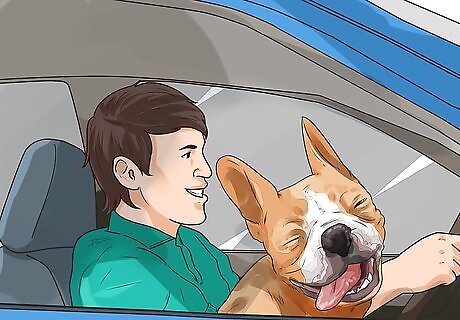
Set up your pickup. Once you have filled out all of the paperwork and received the shelter’s approval, you are ready to bring your new pet home. Set up a time to pick up your pet from the shelter and bring them to their new, permanent home. Make sure you have proper transportation. Even if your local public transit systems allow pets on board, it may be a scary or confusing trip for your dog, and they could lash out. Make sure you have a car or a ride lined up to get your pet home quickly and with minimal stress. Arrange to pick your pet up on a day where you will be able to stay with it the whole day. Your new dog will likely be confused and a little scared. Leaving them alone for extended periods right after you bring them home won’t help that. Take the day to get to know your new dog, and help acclimate them to their new environment.
Caring for Your Adopted Dog

Train a puppy. If you bring home a puppy, they may have lots of energy that needs to be properly cared for. Enroll you and your puppy in a basic behavioral training class. This will not only teach your puppy proper behavior, it will help you learn how to deal with some of their less-adorable actions and habits. The key to training is consistency. Attend every class, and practice commands and behaviors at home in between classes. Consider further training if your puppy still needs some discipline after they finish their basic puppy training. Local pet stores often have training classes for both puppies and newly adopted pets. Contact a local store to see if they offer classes, or to get recommendations for local trainers.
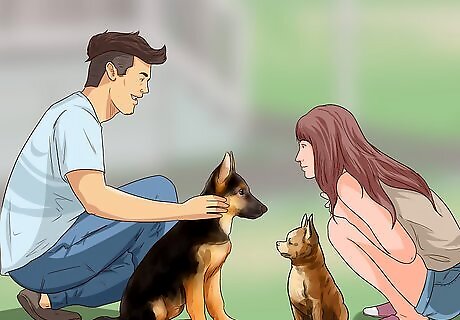
Socialize your dog. It is important for your new dog to be able to interact with both other dogs and people in a healthy, respectful way. Socialize your dog by introducing them to other dogs and new people, and training them to properly interact. Understand that this may take time with a rescued animal. Rescue animals can be shy or cautious. It is important to offer the opportunity to socialize, but do not force them into any action. This could cause harm to both your dog and whomever they interact with. Start with exposure to friends and family in the home. Allow your dog to meet new people in familiar surroundings before leaving them with new people for any extended period of time. Try a dog park to get your dog socializing with other dogs. If you believe your new dog may be too aggressive to socialize with other dogs or people, work with a behavioral specialist to help train them. This often comes from previous training, or a place of fear within the dogs. Proper training can help them learn proper behavior with positive reinforcement.

Get a vet check. Even if the shelter provided vet work for your new dog, it is important to get your dog a vet check once you bring them home. This allows your dog and your vet to get to know one another. It also lets your vet assess your new pet and set them up on the right care plan for their needs. Call your vet and let them know that you have a new dog. Ask to set up an initial visit to introduce your dog to your vet and set up a care package for your pet.

Be patient. Your new dog is likely being asked to understand a great deal of information all at once. On top of that, they may be dealing with their own mental stresses from their abandonment or life in their former home. Practice patience and understanding with your new dog as they acclimate to their new home. Avoid stereotypical but often harmful reinforcement behaviors such as hitting the dog, even lightly, with a rolled up newspaper or rubbing their nose in spots where they have an “accident.” Reward positive behaviors with affection, affirmation, and treats. Try not to react at all to negative behaviors unless they pose an immediate threat to the dog or someone else. Work with a trainer or behavioral specialist, if necessary, to find the right set of training techniques for you and your pet. Do not give up on your new dog if they do not act the way you want right away. Keep working with them and reinforcing good behavior.

















Comments
0 comment